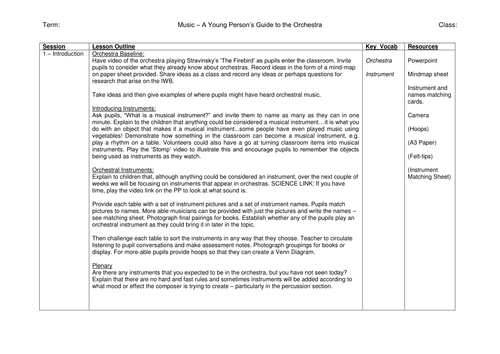











This is a unit of work that I created for use with Years 3, 4, 5 & 6. It spans six sessions, although it can run for A LOT longer if desired! Although I am a musician, it requires no musical knowhow whatsoever to teach! I was very conscious of this as I was sharing the resource with teachers who lacked confidence in their musical knowledge and skills. This unit focuses predominately on listening, appraisal and understanding, but there are also opportunities for composition and performance included. KS2 Music Attainment Targets Covered:
• Pupils should be taught to listen with attention to detail and recall sounds with increasing aural memory.
• Appreciate and understand a wide range of high quality music drawn from a wide range of high-quality live and recorded music drawn from different traditions and from great composers and musicians.
• Develop an understanding of the history of music.
There are also optional links to Science within each lesson, which enable you to cover the statutory requirements for teaching sound:
• Identify how sounds are made, associating some of them with something vibrating.
• Recognise that vibrations from sounds travel through a medium to the ear.
• Find patterns between the pitch of a sound and features of the object that produced it.
• Find patterns between the volume of a sound and the strength of the vibrations that produced it.
• Recognise that sounds get fainter as the distance from the sound source increases.
As a Maths Specialist I also couldn’t resist throwing in a few sorting opportunities in the form of Venn and Carroll diagrams!
Overview
• The topic starts with an informal baseline assessment and ends with an informal end of unit assessment.
• Each session focuses on a specific family of the orchestra.
• Pupils enter the classroom each session to an example of music featuring that particular family, giving them the opportunity to appraise music and develop their own taste.
• Pupils learn what each orchestral instrument is called, what it sounds like and how it produces sound.
• Pupils become familiar with the terms pitch, timbre, vibration, dynamics and tempo.
• Children conduct research and learn through activities; however, notes are included for classrooms where ICT/books are not readily available or where pupils lack sufficient research skills.
• Activities are fun and active - with low entry and high ceiling for differentiation.
• A wode range of activities, e.g. rapping, sorting, poster making, ‘Happy Families’, interactive whiteboard games, mind-maps and guessing games.
• Very little marking is required, as the activities lend themselves to being carried out in a group and outcomes can often be photographed or filmed for evidence.
Planning, powerpoint and all paper resources are included. I hope you enjoy!
Something went wrong, please try again later.
Excellent resource thank you!
Looks like a fabulous piece of planning and has saved me hours! Thank you so much! Planning to use with Years 3 and 4 but could easily be used for other year groups.
Fab resource!
This is super. I intend to use it for year 3. Thank you.
Very helpful resource to teacher about the orchestra. I made a few changes but it is a good starting point.
Report this resourceto let us know if it violates our terms and conditions.
Our customer service team will review your report and will be in touch.